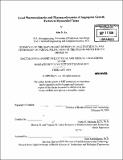| dc.contributor.advisor | Elazer R. Edelman. | en_US |
| dc.contributor.author | Le, Kha N., 1973- | en_US |
| dc.contributor.other | Harvard University--MIT Division of Health Sciences and Technology. | en_US |
| dc.date.accessioned | 2010-04-28T17:05:18Z | |
| dc.date.available | 2010-04-28T17:05:18Z | |
| dc.date.copyright | 2009 | en_US |
| dc.date.issued | 2009 | en_US |
| dc.identifier.uri | http://hdl.handle.net/1721.1/54585 | |
| dc.description | Thesis (Ph. D.)--Harvard-MIT Division of Health Sciences and Technology, 2009. | en_US |
| dc.description | Cataloged from PDF version of thesis. | en_US |
| dc.description | Includes bibliographical references. | en_US |
| dc.description.abstract | Early enthusiasm over angiogenic therapy, a method to induce vascular regeneration to treat ischemic tissue with growth factors, has been tempered by a series of unsuccessful clinical trials with limited late efficacy and a wide range of mixed results. This thesis was designed to examine critically whether the lack of late efficacy of local delivery of angiogenic factors could be explained by a comprehensive understanding of local pharmacokinetics (PK) and pharmacodynamics (PD) in the myocardial tissue. Our central hypothesis is that early success at inducing vessel growth powerfully self-regulates angiogenic therapies by dynamically altering local tissue pharmacokinetic properties and hinders long-term efficacy. We used a multipronged approach to investigate this hypothesis. We characterized the baseline local myocardial PK through a series of ex-vivo isolated heart studies and mathematical analysis, examined the local coupling of PK and PD with an in-vivo ischemic heart model, created a computational model of myocardial PK and PD to predict distribution of growth factors and their biologic effects, discussed implications and future studies. Our findings suggest that microvascular washout impedes myocardial drug transport, early angiogenic response further exacerbates drug washout and is likely responsible for late vessel regression, modulating drug PK properties to mitigate drug clearance through washout can enhance late tissue response. These results imply that local PK-PD interdependence should be carefully examined to improve clinical efficacy of angiogenic therapy with local angiogenic growth factor delivery. | en_US |
| dc.description.statementofresponsibility | by Kha N. Le. | en_US |
| dc.format.extent | 142 p. | en_US |
| dc.language.iso | eng | en_US |
| dc.publisher | Massachusetts Institute of Technology | en_US |
| dc.rights | M.I.T. theses are protected by
copyright. They may be viewed from this source for any purpose, but
reproduction or distribution in any format is prohibited without written
permission. See provided URL for inquiries about permission. | en_US |
| dc.rights.uri | http://dspace.mit.edu/handle/1721.1/7582 | en_US |
| dc.subject | Harvard University--MIT Division of Health Sciences and Technology. | en_US |
| dc.title | Local pharmacokinetics and pharmacodynamics of angiogenic growth factors in myocardial tissue | en_US |
| dc.title.alternative | Local PK and PD of angiogenic growth factors in myocardial tissue | en_US |
| dc.type | Thesis | en_US |
| dc.description.degree | Ph.D. | en_US |
| dc.contributor.department | Harvard University--MIT Division of Health Sciences and Technology | |
| dc.identifier.oclc | 568987524 | en_US |
